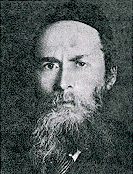Occupation Rabbi Name Avrohom Karelitz Resting place Bnei Brak | Spouse(s) Bashe Bei Role Rabbi | |
 | ||
Born November 7, 1878 ( 1878-11-07 ) Kosava, Grodno Governorate, Russian Empire Other names Avrohom Yishayahu Karelitz Religion Haredi Orthodox Judaism Died October 24, 1953, Bnei Brak, Israel Parents Rabbi Shmaryahu Yosef Karelitz, Rasha Leah Katzenellenbogen-Epstein Similar People Isser Zalman Meltzer, Yona Metzger, Hanan Porat | ||
HARAV NETANELI - MORNING LECTURE DATED 110317 - YAHRZEIT OF CHAZON ISH (AVROHOM YESHAYA KARELITZ)
Avrohom Yeshaya Karelitz, (7 November 1878 – 24 October 1953), popularly known by the name of his magnum opus, Chazon Ish, was a Belarusian born Orthodox rabbi who later became one of the leaders of Haredi Judaism in Israel, where his final 20 years, from 1933 to 1953, were spent.
Contents
- HARAV NETANELI MORNING LECTURE DATED 110317 YAHRZEIT OF CHAZON ISH AVROHOM YESHAYA KARELITZ
- Early life
- Emigration to Eretz Israel
- Influence
- Chazon Ish etrog
- References
Early life
He was born in Kosava, in the Grodno Governorate of the Russian Empire (now Brest Region, Belarus), the eldest son of Rabbi Shmaryahu Yosef Karelitz, the Rav of Kosova; his mother was Rasha, the daughter of Rabbi Shaul Katzenelbogen. His younger brothers were Rabbi Meir, Rabbi Yitzchak, and Rabbi Moshe. Rabbi Yitzchak Karelitz succeeded their father as the Rav of Kosova; he and his wife and daughter were shot to death in their home by the Germans in mid-1942. A sister, Miriam, would eventually marry Rabbi Yaakov Yisrael Kanievsky, the Steipler Gaon. The Steipler referred to his brother-in-law, Rabbi Avrohom Yeshaya, as his mentor as long as the latter was alive.
As a youth, Rabbi Karelitz was sent to study under Rabbi Chaim Soloveitchik of Brisk. He did not take to the Brisker method of study, and later it became clear that he actually opposed it. After two years, he returned home and continued his education, learning with his father who was head of the local Beth din. He married Bashe Bei.
Emigration to Eretz Israel
He moved to Vilna in about 1920, and became close to Rabbi Chaim Ozer Grodzinski, consulting with him in all religious and communal matters. Encouraged by Rabbi Grodzinski and with Rabbi Abraham Isaac Kook’s help, the Chazon Ish settled in Eretz Israel, then the British Mandate of Palestine, in 1933. His house in Bnei Brak became the address for thousands who sought his guidance.
Rav Karelitz manifested unusual talent and diligence from an early age. He devoted his life to the study of Torah while simultaneously gaining knowledge in secular sciences such as astronomy, anatomy, mathematics, and botany. After his marriage, he continued to lead an extremely modest life, his wife providing for their needs while he spent day and night studying Torah in-depth. He did not have any children.
Influence
Though he held no official position, the Chazon Ish nevertheless became a recognized worldwide authority on many matters relating to Jewish law and life. He was not appointed as communal leader, yet his positions and rulings influenced the life and institutions of religious Jewry, especially in Israel. He did not publish many responsa, yet still achieved recognition as a leading authority on halakha.
He declined to participate in any of the religious-political movements which were very active prior to, and during the formation of the State of Israel in 1948. Yet, he had an immense influence on Haredi Judaism in Israel, whose formative period coincided with his years in Israel.
In recognition of his deep insight and broad awareness and interest in many fields of study, many sought his guidance on social and political issues. David Ben-Gurion, the prime minister of Israel, and Yitzhak Ben-Zvi, who became the second president of Israel, visited him once to discuss political-religious issues. The story is told that the Chazon Ish argued that the secular community's needs should defer to those of the religious community. He used the Talmudic discussion (Sanhedrin 32b) of two camels which meet on a narrow mountain pass as a metaphor. A camel without goods was expected to defer to a camel laden with goods; similarly, the Chazon Ish contended secular society should defer to religious society, which bore the "goods" of tradition.
"Chazon Ish etrog"
There is a variety of Balady citron in his name, which he certified for use as an etrog of the Four species. After one Sukkot, the Chazon Ish handed Rabbi Michel Yehuda Lefkowitz a packet of seeds taken from the etrog he had used for the festival and instructed him to plant them in his yard. Rabbi Lefkowitz, who had no agricultural experience, followed his mentor's instructions to plant and water it, and the tree grew and bore fruit. Every year the Chazon Ish came to select his etrog for the holiday from the tree, as did his brother-in-law, the Steipler Gaon, and other Gedolei Yisrael. Rabbi Lefkowitz also allowed etrog growers to take cuttings from the tree to grow entire orchards of etrogim certified as kosher (mehudar) by the Chazon Ish.
